Miriam A. Manary, Nichole L. Ritchie, and Lawrence W. Schneider
University of Michigan Transportation Research Institute
ABSTRACT
Three sled tests simulating side-impact collisions were conducted to identify safety issues associated with protection of wheelchair-seated occupants. In each test, a midsize adult male anthropomorphic test device (ATD) was restrained by a three-point belt and seated in a commercial transit wheelchair that was secured by a four-point strap-type tiedown. In two tests, the shoulder was belt routed over the outboard shoulder, while it was routed over the inboard shoulder in the third test. The wheelchair was well secured in all three tests, but the ATD’s head and upper torso were not effectively restrained with the outboard shoulder belt routing. In two tests, the ATD loaded and severely deformed the wheelchair armrest. The ATD upper torso was more effectively restrained when the shoulder belt was positioned over the inboard shoulder but the improved overall restraint could potentially increase load on the occupant neck.
KEYWORDS
Wheelchairs, transportation, crash safety, side impact crashes
BACKGROUND
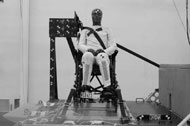 |
|---|
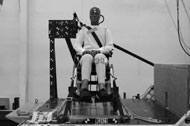 |
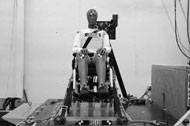 |
ANSI/RESNA WC/19 Wheelchairs for Use in Motor Vehicles (WC/19) and the SAE Recommended Practice J2249 Wheelchair Tiedowns and Occupant Restraint Systems (SAE J2249) set forth design and performance requirements and associated test methods to evaluate the frontal crash performance of occupied, forward-facing wheelchairs and wheelchair tiedown and occupant restraint systems (WTORS) using a 48-kph, 20-g crash pulse (1,2). In developing these seminal wheelchair transportation safety standards, frontal impact protection was recognized as the top safety priority because national data show that more that half of all fatal and disabling injuries to occupants of motor vehicles occur in frontal collisions (3). Side impacts are the second most common cause of occupant trauma, accounting for 27 percent of motor vehicle fatalities and 30 percent of injuries (3). The Rehabilitation Engineering and Research Center on Wheelchair Transportation Safety (RERC on WTS) is currently investigating safety issues related to improving side impact protection for wheelchair-seated occupants.
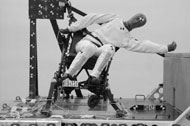 |
|---|
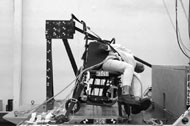 |
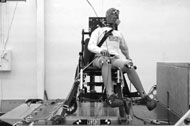 |
In side impact occupant protection, it is important to distinguish between near-side occupants, where the impact is on the same side where the occupant is seated, and far-side occupants, where the impact is on the opposite side of the vehicle from the occupant. The causes of injury and effective countermeasures are distinctly different in these two conditions. For a near-side occupant, injuries are typically on the outboard side of the body and are caused by direct loading of the occupant by the interior of the vehicle. Effective counter measures for near-side crash protection are primarily achieved through improved vehicle design. In protecting an occupant from injury due contact by the intruding side structure of a vehicle, restraint of the occupant and securement of the seat are of little consequence. In contrast, injuries to far-side occupants in side impacts are usually due to an unbelted occupant moving within the vehicle. As a result, belt restraints and effective seat securement are important for reducing injuries to far-side occupants in lateral collisions. Because of this, the focus of the RERC on WTS research and testing is on improving side-impact protection for far-side wheelchair-seated occupants, for which the design and performance of the wheelchair and WTORS can significantly influence the risk of serious injuries.
OBJECTIVES
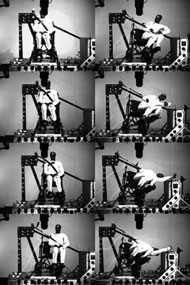 |
|---|
A series of sled tests were performed to identify safety issues for protection of wheelchair-seated occupants. The tests simulated potential outcomes for riders oriented forward-facing in non-powered wheelchair who are involved in moderate-to-severe far-side impacts while using wheelchairs and WTORSs that comply with WC/19 and SAE J2249.
METHODS
Three side-impact sled tests were conducted using a 22 to 30 km/hr (14 to 18-mph), 16-g crash pulse. This crash severity is based side impact tests of mid-sized sedans and represents a moderate-to-severe side impact for a wheelchair rider oriented forward facing in a minivan. A Hybrid II or Hybrid III midsize male ATD with a mass of approximately 77.3 kg (170 lb) was used in all tests and represents the mass and anthropometry of an average US adult male and a nominal adult wheelchair user. The ATD was seated in either a manual or stroller wheelchair that complies with WC/19 and that includes four securement points. Each wheelchair was secured to the sled platform using a SAE J2249-compliant four-point strap-type tiedown. Commercial planar wheelchair seating systems were used in all tests.
In all tests, the ATD was restrained in the wheelchair by a vehicle-anchored three-point belt that complies with SAE J2249. Two tests (A and B) were conducted with the shoulder belt placed over the ATD’s outboard shoulder, which is opposite to the side of the lateral impact and is the typical shoulder-belt routing for a front-seat occupant. The third test (C) was conducted with the shoulder belt crossing the inboard shoulder, which is on the side closest to the impact direction. Figure 1 shows pre-test photos for the three setups and Table 1 summarizes the test conditions. Side and top view high-speed digital video were recorded for each test and allow measurement of the displacement of the wheelchair frame and the leading edge of the ATD head and knee.
| Test ID | Wheelchair type | ATD type | Shoulder-Belt Location | Crash Pulse |
|---|---|---|---|---|
| A | Stroller | Hybrid II | Outboard | 30 km/h, 15.8 g |
| B | Manual | Hybrid II | Outboard | 29 km/h, 16.1 g |
| C | Manual | Hybrid III | Inboard | 23 km/h, 16.4 g |
RESULTS
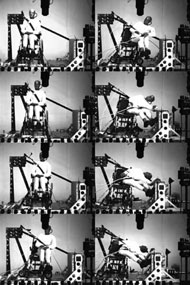 |
|---|
In all tests the wheelchairs remained upright on the sled platform were effectively secured with moderate frame deformation. Figure 2 shows the ATD and wheelchair after test each of the tests. In tests B and C, the ATD loaded and deformed the armrest and, in test B, the armrest fractured. In tests A and B, the ATD was leaning with a torso angle of more than 45 degrees relative to vertical toward the point of impact after the test. In test C, where the ATD moved into the shoulder belt during the test, the ATD was upright and remained seated after the impact.
Figure 3 to 5 are sequenced images from the three tests that give an overview of the ATD and wheelchair motions during the test, show the larger lateral ATD excursion for tests A and B, and illustrate that inboard shoulder belt routing limits ATD motion by contacting the neck of the occupant in test C. Table 2 shows the peak lateral excursions of the center of the wheelchair lower frame and the leading edge of the ATD’s head and knee, measured from the high-speed video. The peak wheelchair excursions are similar for all three tests but the head and knee excursions are much larger when the shoulder belt is on the outboard side. In Test C, with the shoulder belt on the inboard side, interaction of the belt with the ATD’s neck significantly reduced the peak lateral head excursion of the ATD and also reduced the lateral knee excursion.
Test ID |
Wheelchair Excursion mm (in) |
Head Excursion mm (in) |
Knee Excursion mm (in) |
|---|---|---|---|
| A | 238 (9.4) | 938 (36.9) | 809 (31.9) |
| B | 254 (10.0) | 850 (33.5) | 767 (30.2) |
| C | 250 (9.8) | 454 (17.9) | 590 (23.2) |
DISCUSSION AND CONCLUSIONS
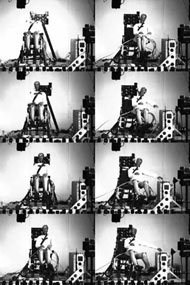 |
|---|
The results of this series of sled tests provide a preliminary look at the issues surrounding wheelchair securement and occupant restraint for wheelchair users in far-side impact crashes. The data show that manual wheelchairs and four-point strap type tiedowns that comply with current voluntary frontal crash standards, are likely to perform well under these loading conditions when the wheelchair user is restrained by a vehicle-anchored three-point belt. However, the results highlight the need for improving wheelchair user restraint in far-side impacts when the shoulder belt is in the typical position over the outboard shoulder, as well as a need to improve the design of wheelchair armrests and side frames to reduce the potential for abdominal injury to the wheelchair user. Placement of the shoulder belt over the inboard shoulder reduces lateral excursions of the wheelchair users and reduces the chance of head strike during the crash. The interaction of the shoulder belt with the ATD potentially increases loading to the neck, which could be a source of injury.
These differences in ATD response due to differences in shoulder belt routing for vehicle-anchored belts indicate the need to investigate the performance of wheelchairs and response of the ATD when the wheelchair user is restrained by a wheelchair-anchored lap belt as well as by a fully integrated harness-type restraint. In this series, the seating systems tested were planar but a fabric seating system might pocket the ATD mass and decrease lateral ATD excursion. Future research will include additional tests for other restraint conditions, with powered wheelchairs, other types of seating systems, and docking-type wheelchair securement systems.
REFERENCES
- ANSI/RESNA Subcommittee on Wheelchairs and Transportation (2000). ANSI/RESNA WC/Vol.1, Section 19:Wheelchair Used as Seat in Motor Vehicles.
- SAE Recommended Practice J2249 (1996) Wheelchair Tiedowns and Occupant Restraints for Use in Motor Vehicles Society of Automotive Engineers, Warrendale, PA.
- National Highway Traffic Safety Administration (2001) Traffic Safety Facts 2001, US Department of Transportation, Washington, D.C.
ACKNOWLEDGMENTS
This study was funded by the NIDRR RERC on Wheelchair Transportation Safety, Grant # H133E010302. The authors would like to thank Carl Miller, Nathaniel Madura, Stewart Simonett, and Charlie Bradley for their diligent efforts.
Miriam Manary
Biosciences Division
University of Michigan Transportation Research Institute
2901 Baxter Road
Ann Arbor, MI, 48109-2150